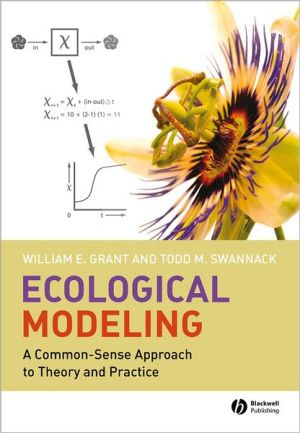

 |

|

Sold Out
Book Categories |
Preface xi
Acknowledgments xiii
Introduction 1
Common-sense solutions: three exercises 1
Modeling theory 2
Modeling practice 2
Theory, practice, and common sense 3
Intended use of this book 3
Common-sense solutions: three exercises
Common-sense solutions 5
Three problems 6
Harvesting food for the winter 6
Estimating the probability of population extinction 12
Managing the Commons 20
The systems approach to problem solving 49
The conceptual model (Phase I) 50
The quantitative model (Phase II) 51
Model evaluation (Phase III) 51
Model application (Phase IV) 51
The three problems revisited: the systems approach in theory and practice 51
Modeling theory
Theory I: the conceptual model 53
State the model objectives (I[subscript a]) 54
Bound the system-of-interest (I[subscript b]) 55
Categorize the components within the system-of-interest (I[subscript c]) 57
State variables 57
Material transfers 59
Sourcesand sinks 61
Information transfers 61
Driving variables 62
Constants 62
Auxiliary variables 62
Identify the relationships among the components that are of interest (I[subscript d]) 63
Submodels 63
Represent the conceptual model (I[subscript e]) 65
Conceptual-model diagrams 65
Describe the expected patterns of model behavior (I[subscript f]) 66
Theory II: the quantitative model 67
Select the general quantitative structure for the model (II[subscript a]) 68
Choose the basic time unit for the simulations (II[subscript b]) 72
Identify the functional forms of the model equations (II[subscript c]) 72
Information on which to base the choice of functional forms 73
Selecting types of equations to represent the chosen functional forms 73
Estimate the parameters of the model equations (II[subscript d]) 75
Statistical analyses within the context of simulation model parameterization 75
Quantifying qualitative information 76
Deterministic- versus stochastic-model parameterization 76
Execute the baseline simulation (II[subscript e]) 77
Baseline simulations for stochastic models 78
Theory III: model evaluation 79
Assess the reasonableness of the model structure and the interpretability of functional relationships within the model (III[subscript a]) 81
Evaluate the correspondence between model behavior and the expected patterns of model behavior (III[subscript b]) 82
Examine the correspondence between model projections and the data from the real system (III[subscript c]) 84
Quantitative versus qualitative model evaluation 86
Determine the sensitivity of model projections to changes in the values of important parameters (III[subscript d]) 86
Interpreting sensitivity analysis within a model evaluation framework 87
Theory IV: model application 89
Develop and execute the experimental design for the simulations (IV[subscript a]) 89
Analyze and interpret the simulation results (IV[subscript b]) 91
Communicate the simulation results (IV[subscript c]) 91
Modeling practice
Some common pitfalls 93
Phase I pitfalls: the conceptual model 93
Phase II pitfalls: the quantitative model 97
Phase III pitfalls: model evaluation 100
Phase IV pitfalls: model application 102
The modeling process in practice 105
Preliminary conceptual model (CM) 106
How to begin 106
Adding new components to the model 108
Describing expected patterns 108
Describing the plan of attack 108
Intermediate developmental models (IDM[subscript i]) 109
Evaluate-adjust cycle for each developmental model 110
Sensitivity analysis of the last developmental model 112
Final model (FM) 112
Theory, practice, and common sense
The common-sense problems revisted 115
Harvesting food for the winter 115
The preliminary conceptual model (CM) 115
The last (only) intermediate development model (IDM[subscript last]) 116
The final model (FM) 117
Estimating the probability of population extinction 117
The preliminary conceptual model (CM) 117
The intermediate development models (IDM[subscript i]) 118
The final model (FM) 118
Managing the Commons 118
The preliminary conceptual model (CM) 118
The intermediate development models (IDM[subscript i]) 120
The final model (FM) 121
Reflections 123
The systems approach as a complement to other methods of problem solving 123
Ecological modeling as a problem-solving process 126
Expectations for ecological models 127
A final thought 129
References 131
Introduction to the ecological modeling literature 133
Scientific reports for the examples in Chapter 2 139
Effect of deforestation on rate of food harvest 139
Effect of hurricane frequency on probability of population extinction 141
Effect of stocking rate on forage and animal production 143
Index 149
Login|Complaints|Blog|Games|Digital Media|Souls|Obituary|Contact Us|FAQ
CAN'T FIND WHAT YOU'RE LOOKING FOR? CLICK HERE!!! X
 You must be logged in to add to WishlistX
 This item is in your Wish ListX
 This item is in your CollectionEcological Modeling: A Common-Sense Approach to Theory and Practice
X
 This Item is in Your InventoryEcological Modeling: A Common-Sense Approach to Theory and Practice
X
 You must be logged in to review the productsX
 X
 X

Add Ecological Modeling: A Common-Sense Approach to Theory and Practice, Ecological Modeling: A Common-Sense Approach to Theory and Practice is a down-to-earth guide for students, teachers, and professional ecologists. The text candidly addresses the question What do I really need to know to begin building and using ecologica, Ecological Modeling: A Common-Sense Approach to Theory and Practice to the inventory that you are selling on WonderClubX
 X

Add Ecological Modeling: A Common-Sense Approach to Theory and Practice, Ecological Modeling: A Common-Sense Approach to Theory and Practice is a down-to-earth guide for students, teachers, and professional ecologists. The text candidly addresses the question What do I really need to know to begin building and using ecologica, Ecological Modeling: A Common-Sense Approach to Theory and Practice to your collection on WonderClub |